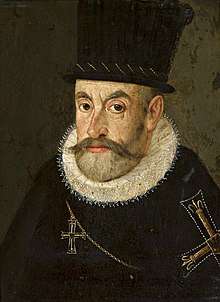Maximilian III, Archduke of Austria
Maximilian III of Austria, briefly known as Maximilian of Poland during his claim for the Throne (12 October 1558 – 2 November 1618) was the Archduke of Further Austria from 1612 until his death.
| Maximilian III | |
|---|---|
| Archduke of Austria Grand Master of the Teutonic Order | |
 Portrait by Hans Henseiller, 1590s, National Museum in Warsaw | |
| Archduke of Further Austria | |
| Reign | 26 June 1612 – 2 November 1618 |
| Predecessor | Matthias |
| Successor | Matthias |
| King of Poland Grand Duke of Lithuania (contested) | |
| Reign | 27 September 1587 – 9 March 1589 |
| Predecessor | Stephen Báthory |
| Successor | Sigismund III Vasa |
| Born | 12 October 1558 Wiener Neustadt, Austria |
| Died | 2 November 1618 (aged 60) Wien, Austria |
| House | Habsburg |
| Father | Maximilian II, Holy Roman Emperor |
| Mother | Maria of Spain |
| Religion | Roman Catholicism |
Biography
Born in Wiener Neustadt, Maximilian was the fourth son of the emperor Maximilian II and Maria of Spain. He was a grandson of Anna of Bohemia and Hungary, daughter and heiress of Vladislaus II of Bohemia and Hungary, who himself was the eldest son of Casimir IV of Poland from the Jagiellonian Dynasty.
From 1585 Maximilian became the Grandmaster of the Teutonic Order; thanks to this he was known by the epithet der Deutschmeister ("the German Master")[1] for much of his later life.
In 1587 Maximilian stood as a candidate for the throne of Polish-Lithuanian Commonwealth, following the death of the previous king, Stefan Batory. A portion of the Polish nobility elected Maximilian king, but, as a result of the rather chaotic nature of the election process, another candidate, Sigismund III Vasa, prince of Sweden, grandson of Sigismund I the Old, was also elected. Maximilian attempted to resolve the dispute by bringing a military force to Poland – thereby starting the war of the Polish Succession. His cause had considerable support in Poland, but fewer Poles flocked to his army than to that of his rival. After a failed attempt to storm Kraków in late 1587, he was defeated in January 1588, at Pitschen in Silesia (Battle of Byczyna) by the supporters of Sigismund III (who had since been formally crowned), under the command of Polish hetman Jan Zamojski. Maximilian was taken captive at the battle and was only released a year and half later after the intervention of Pope Sixtus V in the aftermath of the Treaty of Bytom and Będzin. In 1589, he formally renounced his claim to the Polish crown.[2] The inactivity of his brother, the emperor Rudolf II, Holy Roman Emperor in this matter contributed to Rudolf's poor reputation.
From 1593 to 1595 Maximilian served as regent for his young cousin, Ferdinand, Archduke of Inner Austria. In 1595 he succeeded their uncle Ferdinand II, Archduke of Further Austria in his territories, including Tyrol, where he proved to be a solid proponent of the Counter-Reformation. He also worked to depose Melchior Khlesl, and to ensure that Archduke Ferdinand of Inner Austria, his former charge, succeed as Holy Roman Emperor.
Today, Maximilian is perhaps best remembered for his baroque archducal hat, exhibited in the treasury of the monastery of Klosterneuburg and was used for ceremonial purposes as late as 1835.
He died at Vienna in 1618, and is buried in the canopied tomb in Innsbruck Cathedral.
Ancestors
References
| Wikimedia Commons has media related to Maximilian III, Archduke of Austria. |
- In fact, originally the titles Hochmeister ("Grandmaster") and Deutschmeister ("German Master") were different: while Grandmaster was the highest order dignitary, the German Master was the third highest and territorially restricted to area of the Holy Roman Empire (apart from Prussia and Livonia) where he administered its respective bailiwicks. But after 1561 those ranks were united and the Deutschmeister became Grandmaster.
- Sławomir Leśniewski (January 2008). Jan Zamoyski – hetman i polityk (in Polish). Bellona. pp. 111–118. GGKEY:RRA1L0T4Y81.
- Holland, Arthur William (1911). . In Chisholm, Hugh (ed.). Encyclopædia Britannica. 17 (11th ed.). Cambridge University Press.
- Wurzbach, Constantin, von, ed. (1861). . Biographisches Lexikon des Kaiserthums Oesterreich [Biographical Encyclopedia of the Austrian Empire] (in German). 7. p. 112 – via Wikisource.
- Poupardin, René (1911). . In Chisholm, Hugh (ed.). Encyclopædia Britannica. 5 (11th ed.). Cambridge University Press.
- Press, Volker (1990), "Maximilian II.", Neue Deutsche Biographie (NDB) (in German), 16, Berlin: Duncker & Humblot, pp. 471–475; (full text online)
- Chisholm, Hugh, ed. (1911). . Encyclopædia Britannica. 15 (11th ed.). Cambridge University Press.
- Priebatsch, Felix (1908), "Wladislaw II.", Allgemeine Deutsche Biographie (ADB) (in German), 54, Leipzig: Duncker & Humblot, pp. 688–696
- Boureau, Alain (1995). The Lord's First Night: The Myth of the Droit de Cuissage. Translated by Cochrane, Lydia G. The University of Chicago Press. p. 96.
- Noubel, P., ed. (1877). Revue de l'Agenais [Review of the Agenais]. 4. Société académique d'Agen. p. 497.
- Charles V, Holy Roman Emperor at the Encyclopædia Britannica
- Wurzbach, Constantin, von, ed. (1861). . Biographisches Lexikon des Kaiserthums Oesterreich [Biographical Encyclopedia of the Austrian Empire] (in German). 7. p. 19 – via Wikisource.
- Stephens, Henry Morse (1903). The story of Portugal. G.P. Putnam's Sons. pp. 125, 139, 279. Retrieved 11 July 2018.
- Harris, Carolyn (2017). Raising Royalty: 1000 Years of Royal Parenting. Dundurn Press. p. 78.
| Preceded by Ferdinand II, Archduke of Further Austria Archduke Mathias, his elder brother |
Governor of Tirol Archduke of Further Austria 1612–1618 |
Succeeded by Leopold V, Archduke of Further Austria his first cousin |
| Preceded by Charles II, Archduke of Inner Austria |
Regent of Styria 1593–1595 |
Succeeded by Ferdinand III, Archduke of Inner Austria |
| Preceded by Heinrich von Bobenhausen |
Grand Master of the Teutonic Order 1590–1618 |
Succeeded by Archduke Charles III of Austria |